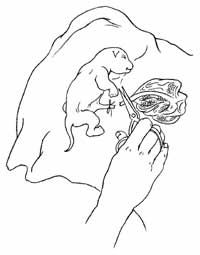 “©2006 Publications International, Ltd.Method A, Step 2
“©2006 Publications International, Ltd.Method A, Step 2
The beauty of birth is a rewarding experience, but most cats don’t want onlookers during delivery. It is important in cat care to be ready in case complications occur. Despite all your preparations, the cat may have them someplace else.
In preparation for queening or a cat giving birth, the cat will become very restless and very vocal. Often a queen will dig around the queening box as if nesting and will lose interest in food. These signs may indicate birth will occur within 24 hours.
If any of the following situations occur, the cat needs immediate veterinary care:
- Failure to deliver within three hours of intermittent labor
- Failure to deliver within 30 minutes of continuous hard labor.
- Heavy, bright-red bleeding during labor.
- Brown or foul-smelling discharge during labor.
- General weakness of the mother.
- Failure to deliver by the 66th day of gestation.
- Presentation of the first water sac with no delivery after one hour.
It is absolutely vital to provide a secluded place for the mother to have her litter. After delivery, the kittens should not be touched or disturbed. If a cat is having problems with the birthing process, use the following cat care tips.
If the Kitten is Stuck in the Birth Canal
Method A
Step 1: Grasp the kitten with a clean towel.
Step 2: Applying steady traction, gently pull the kitten at a slight downward angle. Continue pulling gently and steadily until the kitten is delivered.
Step 3: If you are unable to remove the kitten, or if the mother is uncooperative, contact the veterinarian immediately.
 “©2006 Publications International, Ltd.Method B, Step 2
“©2006 Publications International, Ltd.Method B, Step 2
If the Kitten Isn’t Cleaned by the Mother After Delivery
Method B
Step 1: Put the kitten, covered in the fetal membrane, into a clean towel.
Step 2: Peel the membrane off its face immediately.
Step 3: Continue to pull the membrane from its body. The membrane will collect around the umbilical cord. Do not pull on the umbilical cord.
Step 4: Wipe any fluid off the kitten’s nostrils and mouth. Rub its body vigorously with a towel to stimulate breathing.
Step 5: If there is heavy mucus in the mouth and nose, clean out what you can with your finger.
 “©2006 Publications International, Ltd.Method B, Step 7
“©2006 Publications International, Ltd.Method B, Step 7
Step 6: If the kitten is still having trouble breathing:
Step 6a: Place the kitten on its back on a towel in the palm of your hand.
Step 6b: Cradle its head by closing your thumb toward your fingers.
Step 6c: Using your other hand to secure the kitten, lift your hands to head level and swing firmly down toward the floor. Repeat several times.
Step 6d: Vigorously rub the kitten again with the towel.
Step 6e: Stop when the kitten is actively moving and crying.
Step 7: Tie a thread around the umbilical cord about one inch above the kitten’s abdomen. Leaving the tied position attached to the kitten, cut off the rest of the umbilical cord and fetal membrane.
Step 8: Place the kitten with its mother. She will take care of the rest. If she does not take care of the kittens, or if any other problem develops, contact the veterinarian as soon as possible.
©Publications International, Ltd.





























